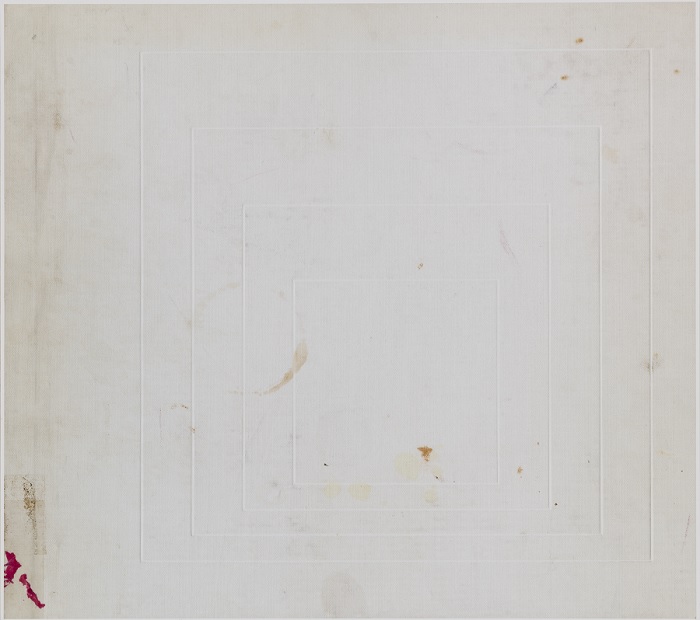
Hannah Karsen
American, 1989-
Untitled 2, 2016
archival pigment print
19 × 21 × 1 1/2 in.
SBMA, Museum purchase with funds provided by PhotoFutures
2018.22.2
COMMENTS
After hours spent sifting through pages hoping to find more handwritten notes, detritus of use, I came upon something else. The dingy pathos of white covered art books that have become marked over time. These white book covers are particularly vulnerable surfaces, especially so in public libraries. Finney’s words were the first of which I drew from when thinking about these surfaces. Likening the surface of the book to the surface of a fresh, white piece of paper holding
a different kind of handwriting.
These found abstractions are kept within the materiality and texture on these surfaces, and hold the index of movement and use. I encountered these objects within a specific type of looking, a viewing platform that I’ve created, check them out as others have done, and scan the surface. Holding the imprint and accumulation of the mark in my photograph, I’ve marked a point in its orbit. Thinking about how I’ve used film in the past, I wanted the sensitized surface of the scanning bed and to utilize light to think about the physicality of this information. The texture of the fabric and the information that held was important to retain.
The record of these scanned surfaces of the books serve as documents of when I came upon them. The titles of these works further serve to address this, as I have researched how many times each book has been checked out, and used that number for the title of each piece. Citing a number for the title dealt with the object as it is used, circulated, addressing its state and discoloration in a way. The numbers were surprising to me to hold into account when looking at the amount of mark making that had occurred. It is with this information that I began to think about how this object was cared for and handled. The number addresses that they operate in a public and private space and are subjected and influenced, by these factors. It also holds a particular index speaking to a sentimentality I began to hold for these objects.
This numbering functioned over the title of the book as the title for these works, in a decision to disclude addressing the artists’ work housed within. The focus is placed back on the covers that have become fields, abstractions. Though, I can’t disregard the whiteness of my scope both unintentionally with artists chosen, and intentionally with the surface color of these books. The decision for the white cover was arrived at despite finding numerous brilliantly colored book covers with marks that occupied space in this type of looking. But white felt so fragile, and the readiness for a mark became so palpable.
In thinking about the fabric of these covers I used surface and skin to describe them, and carried this through when thinking about the paper chosen for the final prints. Choosing an inkjet paper, one is made to think about the warmth or coolness of white, how well it can hold tonalities of the print, the subtleties of the subject matter. In choosing a Hahnemuhle paper as I’ve done, dealing with a surface structure, an element I wanted to emulate in thinking of the texture of these scanned surfaces, was also carefully thought about. The shift in paper type did not just deal with emulating a surface texture, but also transposed a presence for the print, imbuing a different quality to the print that felt more substantive. The prints felt as though they were reaching out of emulation and into a presentness of their own.
I’ve presented five photographs from this ongoing body of work, a number of times, in this exhibition and have meticulously considered presentation in a way I have not realized for my work before. The photographs are mounted to dibond, framed with white wash wood, and finished with museum glass. The effect of this presentation concretizes these marks in a poignant way acknowledging accumulation, temporality, efflorescence.
- Hannah Kit Karsen, Metaphysical Subtleties, MFA Thesis, UC Riverside, 2016, pp. 28-29
SBMA CURATORIAL LABELS
Spending time in various libraries’ art history sections, Los Angeles-based artist Hannah Karsen became interested in special collection art books that had been covered over with protective neutral canvas. In one of her photographs, the embossed motif of a Joseph lbers “Homage to the Square” appears to have pressed its way through the cloth. Other books’ subjects remain unknown, yet their incidental cover markings uncannily correspond to paintings by Mark Rothko, Robert Ryman, and Agnes Martin. Regardless of their subjects, the photographs themselves are so meticulously shot and developed that they appear not to be photographs at all, but the very cloth that they are picturing. Some even take on the look of an abstract painting or drawing that has been framed and placed on a wall. The marks of use the books carry, however, attest to their status as everyday objects rather than works of art themselves. A coffee mug stain; smudges perhaps left by students carrying a book to and from the studio; a dash of red paint from an errant brush; tape used to reinforce the cloth—all these come into play as reminders of the photographs’ original painterly subject, whose identity remains endlessly fascinating to imagine.
- A Brilliant Spectrum, 2019
